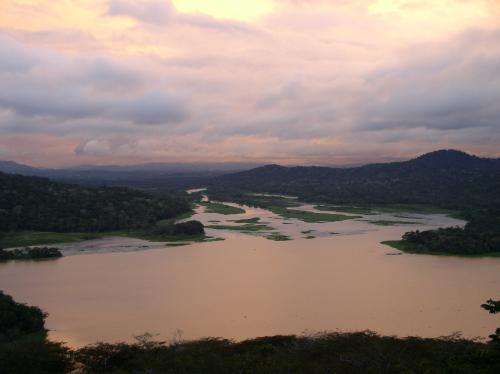Tropical forests mitigate extreme weather events

Tropical forests reduce peak runoff during storms and release stored water during droughts, according to researchers working at the Smithsonian Tropical Research Institute in Panama. Their results lend credence to a controversial phenomenon known as the sponge effect, which is at the center of a debate about how to minimize flood damage and maximize water availability in the tropics.
During nearly 450 tropical storms, a team of visiting scientists from the University of Wyoming measured the amount of runoff from pastureland, abandoned pastureland and forested land as part of a large-scale land-use experiment in the Panama Canal watershed initiated by STRI.
Data collected by STRI staff and analyzed by University of Wyoming students indicate that land-use history has complex, long-term effects. "We measured large differences in hydrologic response between watersheds with different land-use histories and land cover," said Fred Ogden, STRI Senior Research Associate and Civil Engineering Professor at the University of Wyoming. "Our ultimate objective is to better understand these effects and include this improved understanding in a high-resolution hydrological model that we are developing to predict land-use effects in tropical watersheds."
"The result for storm peaks is spectacular," said Robert Stallard, hydrologist at STRI and the United States Geological Survey who developed the statistics for data analysis. "Storm-water runoff from grazed land is much higher than from forested land. The results are clearest after big storms." On the other hand, forests released more water than grasslands and mixed-use landscapes during the late dry season, pointing to the importance of forests in regulating water flow throughout the year in seasonal climates.
Evidence to support the sponge effect was lacking for tropical forests, leading some to question its validity. "One of reasons why there isn't more scientific evidence for the sponge effect is that you have to take what nature dishes out," said Stallard, a staunch proponent of the sponge effect, who is often seen wearing Sponge Bob socks. "It requires a long-term institutional commitment to get good results. The USGS, STRI, University of Wyoming and the Panama Canal Authority have the resources to do that."
Severe drought forced Panama Canal authorities to impose draft restrictions on transiting ships in 1997. In 2010, a major December storm system, examined in this study, halted shipping in the canal for 17 hours. Land use in the watershed not only affects world commerce but also water availability for Panama's major urban areas. The study is particularly relevant to land use decisions throughout the tropics where more than 50 percent of forests are now "secondary" forests that have grown back after logging or on abandoned pastureland.
The 700-hectare Panama watershed experiment, also known as Agua Salud, will run for 20 to 30 years, making it the largest ongoing study of land use in the tropics.
"Our project aims to clearly quantify environmental services such as water flow, carbon storage and biodiversity conservation that decision makers will consider as they evaluate projects from forest restoration to watershed management," said Jefferson Hall, Smithsonian staff scientist and project director.
More information: Ogden, F.L., Crouch, T.D., Stallard, R.F., Hall, J.S. 2013. Effect of land cover and use on dry season river runoff, runoff efficiency and peak storm runoff in the seasonal tropics of central Panama. Water Resources Research. Online. DOI: 10.1002/2013WR013956
Journal information: Water Resources Research
Provided by Smithsonian Tropical Research Institute



















